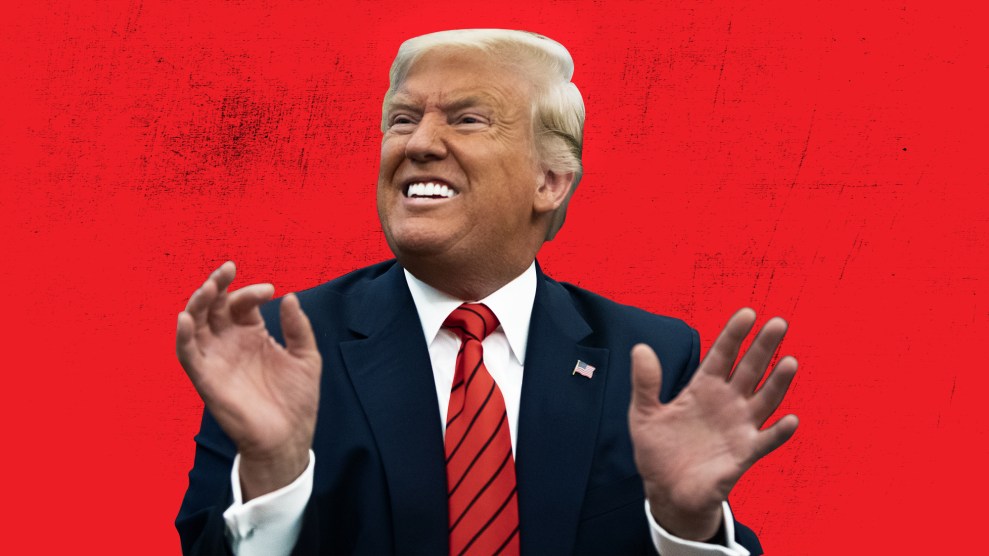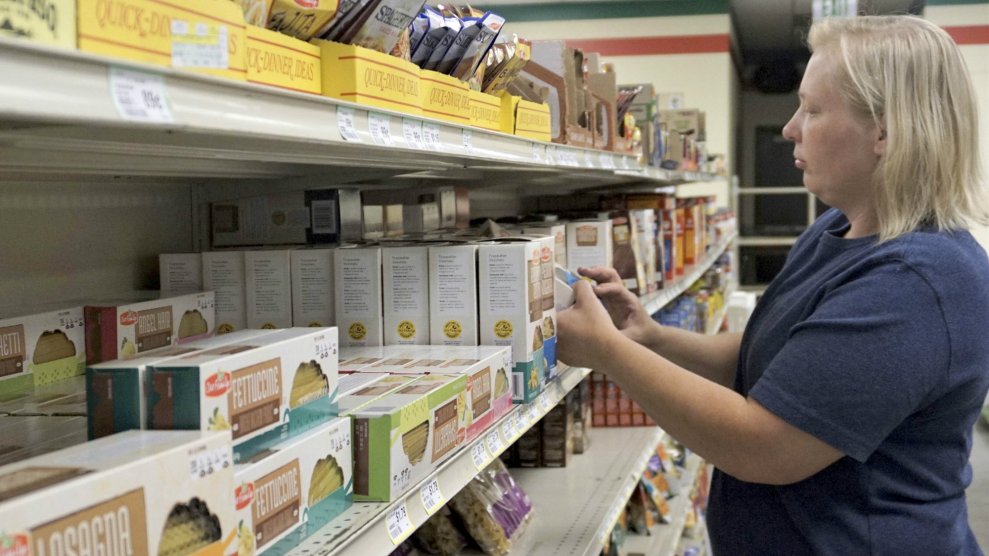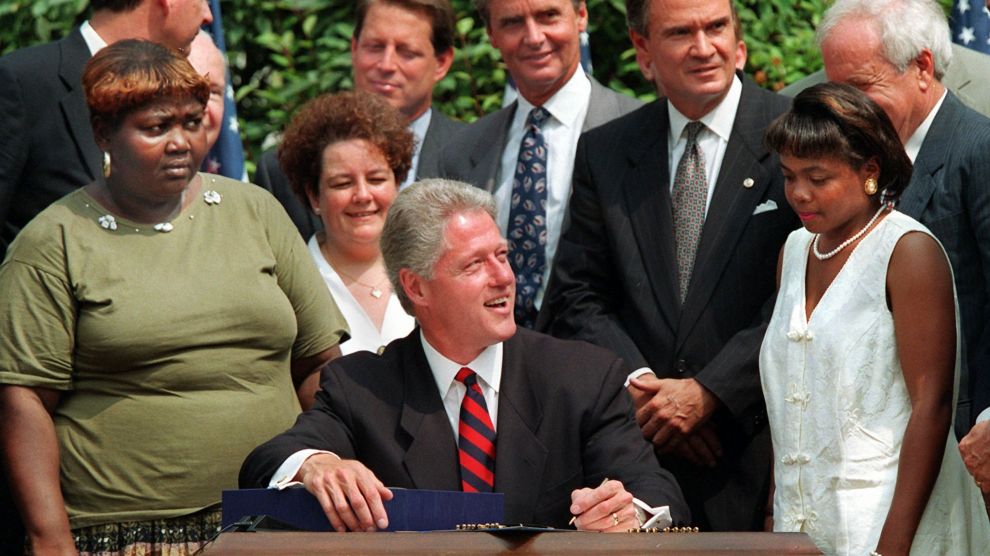
Mother Jones illustration; Manuel Balce Ceneta/AP
This week, President Donald Trump released a $4.8 trillion budget proposal that would further decimate the already weakened social safety net. Trump’s plan would make steep cuts to food stamps, Medicaid, housing assistance, and other welfare programs that millions of Americans rely on.
But the budget is merely a wish list with no chance of passing the Democratic-controlled House. More quietly, Trump has already rolled out a series of bureaucratic changes that have begun to take a tangible toll on the country’s most vulnerable populations and will only inflict more damage in the coming years.
The once-robust social safety net has been steadily dismantled by Republican and Democratic administrations alike. A series of actions, from Ronald Reagan’s fear-mongering about the government subsidizing luxurious lifestyles for welfare recipients to Bill Clinton’s welfare reform that imposed strict work requirement for benefit recipients, have made it tougher than ever to be poor in America. Now Trump is making it even harder.
“There’s been an emphasis on attacking the most vulnerable people in our nation,” says Alexandra Cawthorne Gaines, vice president of the Poverty to Prosperity Program at the Center for American Progress. “It’s just continuous attacks and the creation of additional barriers for people seeking assistance.
Here are the programs that have have taken the biggest hit as a result of this administration’s war on the poor, the sick, and the elderly.
Food Stamps
Mr. Smith, a 45-year-old man living in Washington, DC, scrapes together what passes for a living selling a local newspaper as a street vendor, for which he earns $20 a day—on a good day. Each month, he receives $194 from the the Supplemental Nutrition Assistance Program, commonly known as SNAP or food stamps. Free meals at various churches and nonprofits are essential to bolster the food supply he is able to purchase. When he gets his benefits at the beginning of the month, he buys groceries in bulk, either foods he can store in his freezer or those with a long shelf life.
“You have to budget,” he says. “You have to be really frugal. You have to get three meals a day on $6 or $7.”
On April 1, he will stop receiving his monthly infusion of funds. That’s because of a new Trump administration rule that will cause approximately 700,000 people across the country to be kicked off the SNAP rolls.
SNAP, which is administered by the US Department of Agriculture, feeds more than 40 million Americans each year. Food stamps are vital for low-income people and families and serve as an economic driver across the country, providing customers and revenue for small grocers.
As part of Clinton’s welfare reform, able-bodied adults between the ages of 18 and 50 with no dependents were limited to three months of assistance before they had to prove that they were working at least 20 hours a week. At that point, their benefits would lapse, and they would have to meet certain requirements in order to become eligible again. In the past, governors of states with high unemployment rates could request waivers from the rule, and many able-bodied recipients were able to continue receiving food benefits. Now, the Trump administration’s new rule will tighten the requirements for waivers, making it close to impossible for states to request them. As a result, hundreds of thousands of people will lose SNAP eligibility and have to find new ways to make ends meet.
Without SNAP, Mr. Smith isn’t sure how he’ll eat. And he knows what hunger is like. “You’re in survival mode instead of productive mode,” he says of his time without SNAP benefits. “You’re walking around like a bear foraging for food.” But even given SNAP’s limitations, “that three months of being able to eat is a life saver.”
Cash Assistance
The concept of supporting poor Americans with cash assistance was first established in 1935 as part of the New Deal, when the Great Depression sent 15 million Americans into poverty. Over the subsequent decades, welfare became a top target of Republican mockery, culminating in President Ronald Reagan’s ridicule of so-called “welfare queens” living large on the taxpayers’ dime. After Clinton’s welfare reform overhauled the program in 1996 and imposed work requirements, what was once welfare became known as Temporary Assistance for Needy Families.
Today, 22 of every 100 US families living in poverty receive cash assistance, down from 68 in 1996.
“It ends up being families who are really, really desperate and don’t have any other options,” says LaDonna Pavetti of the Center on Budget and Policy and Priorities.
For instance, a single woman with two children living in South Carolina and collecting TANF benefits receives just $292 each month in cash assistance. That doesn’t cover even a third of the state’s average rent for a two-bedroom home, which is $898. Even in states with more generous benefits—like New Hampshire, where that same family would get $1,066—it doesn’t cover rent for the average two-bedroom unit.
“No one is getting wealthy on TANF,” says CAP’s Cawthorne Gaines.
In most states, families that qualify for TANF are automatically eligible for SNAP. But the Trump administration plans to sever that relationship through a federal rule to close what it calls a “loophole.” In a press release justifying the proposed rule, offering their own version of Reagan’s “welfare queen” trope, the Trump administration claimed that people who don’t need welfare are still claiming it:
The proposed rule would fix a loophole that has expanded SNAP recipients in some states to include people who receive assistance when they clearly don’t need it. In fact, the depth of this specific flexibility has become so egregious that a millionaire living in Minnesota successfully enrolled in the program simply to highlight the waste of taxpayer money.
The Trump administration brags that closing this “loophole” will save taxpayers money. But now, instead of having a streamlined process of receiving TANF and SNAP, families living in poverty will face even more difficulties accessing the funds they need to survive.
Housing Assistance
More than 10 million people in 5.2 million households use government assistance in order to afford housing. Two-thirds of the recipients are seniors, children, or people with disabilities. Most of them receive Housing Choice Vouchers, funded by the Department of Housing and Urban Development and administered by local housing authorities.
But demand for these vouchers far exceeds supply. Waitlists for vouchers in some cities are years’ long.
Under a Clinton-era policy, families with mixed immigration statuses were able to access public housing, so long as at least one member of the family was eligible. Federal subsidies covered only the US citizens or authorized immigrants, but undocumented family members were not barred from living there. The Trump administration proposed a new rule that it claims would shorten waitlists by requiring every member of a voucher-holding household to be a US citizen or legal permanent resident. The rule could leave more than 50,000 children homeless—without actually shortening waitlists. The administration’s own analysis found that the rule would affect 76,000 people—including 55,000 children—in mixed status families who are living in public housing and result in some mixed-status families becoming homeless. And as we reported last May, this is why it wouldn’t have the intended effect of shortening waiting lists:
The subsidies for mixed-status families are prorated so that they only cover the eligible member of the household. Because of this, those families are paying higher rents than households with occupants who are all American citizens or are legal residents. With the proposed rules, housing costs would increase substantially, because entire families would be eligible for subsidized rent. As HUD says in its analysis, the agency would be forced to reduce the quality and quantity of housing to make up for rising costs.
Medicaid
In his 2016 campaign, Donald Trump promised not to touch Medicaid, which provides health insurance to more than 64 million low-income Americans. That hasn’t stopped his administration from launching an all-out assault on the program and its beneficiaries. For many Americans, the program’s seemingly never ending forms, difficult documentation requirements, and practice of kicking recipients off their insurance for minor month-to-month changes in income, makes getting and keeping Medicaid even without the administration’s interference a nearly insurmountable hurdle.
Now the Trump administration is looking to make that process even more complicated. In a warning shot fired in 2017, the administration amended the rules related to section 1115 waivers that allowed states to apply to “experiment” with their Medicaid programs outside of the federal guidelines. The change allowed states to apply for waivers that did not make increasing coverage a goal of the changes to the state program, as opposed to previous years when increasing coverage had to be a part of the “objective” of the change. The next year, it issued a new guidance allowing states to demand work requirements for accessing Medicaid as a part of section 1115 waivers.
Finally, in the most recent and potentially most devastating blow to Medicaid, the administration proposed changing the program to block grants. Currently, in states that expanded Medicaid, for every dollar a state spends on their Medicaid program, the federal government contributes 90 cents. In states that did not expand Medicaid the funds that the federal government matches varies. Under the block-grant system, a fixed amount of money would be made available to the states, but the federal government would make no adjustments to changing needs in the states. That means the rising cost burden of Medicaid would shift entirely to states, which would have a strong incentive to cut coverage and benefits to prevent spending from spiraling.
Experts warn that a block-grant system would devastate Medicaid by limiting funding. Dorianne Mason of the National Women’s Law Center says that if the proposal were to go forward, previous data suggests that Medicaid funding could be cut by $1 trillion over 10 years, decimating coverage for vulnerable populations.
Supplemental Security Income for Disability Benefits
Last month, the Trump administration proposed a change that experts believe will deprive thousands of Americans of disability benefits, with children, the elderly, and those with complicated medical cases bearing the brunt.
Created in 1972, Supplemental Security Income provides monthly cash assistance to low-income Americans who are disabled or elderly. The majority of the more than 8 million recipients of SSI are eligible due to a severe disability and typically have no other source of income. More than 1 million children also receive SSI benefits to help their guardians pay for large medical bills, time off of work to provide care, and other expenses.
For years, conservative lawmakers have attacked SSI benefits, claiming that it is easy to pretend to be disabled. Some have questioned whether many children who receive SSI are being forced to fake disabilities by their parents.
However, signing up for disability benefits is an arduous process, in which recipients, who may already face extra difficulties in filling out paperwork and making doctors’ appointments, are forced to document their entire medical and financial history. Two-thirds of applicants for SSI are rejected, and even those who are ultimately approved can spend years waiting before they ever receive a penny from the government. The majority of SSI recipients receive assistance of less than $600 a month. Since many people with SSI have disabilities that prevent them from working, even with their benefits, more than two-fifths of SSI recipients live below the poverty line.
This year, conservatives may finally get their wish. The Trump administration announced changes in December, to a process known as continuing disability review. Currently, there are three categories of review that indicate how often an SSI recipient’s disability status will be recertified: “medical improvement not expected,” “medical improvement expected,” and “medical improvement possible.”
The administration is creating a fourth category: “medical improvement likely.” It will comprise people with complex cases—such as those whose disabilities don’t fit into the designated categories, people over the age of 55, and children ages 6 and 12—and require them to resubmit their full medical history every two years. Many people in this new category are expected to lose their benefits simply because they will be unable to keep up with all of the documentation required.
Katherine Romig, an expert on SSI at the Center on Budget and Policy Priorities, estimates that the new rule could affect hundreds of thousands of disability beneficiaries.* For recipients whose Medicaid is connected to their SSI status, even temporary gaps in coverage could put their lives at risk. Targeting children age 6 and 12 could be deliberate, argues Matthew Cortland, a disabled, chronically ill, attorney and policy expert, because that’s when children start to use more resources.
In the end, Cortland worries that the administration’s assaults on food stamps, Medicaid, housing assistance, and disability benefits, will combine to make it harder for poor Americans to make ends meet.
“If you were to try to design a policy agenda that had the goal of killing the poorest, most vulnerable Americans,” he said in a statement, “I don’t know that I could come up with a more effective agenda than what the Trump administration has done over the last three years.”
Correction: An earlier version of this article misstated how many people could be affected by the new category of review. The new rule could affect hundreds of thousands of disability beneficiaries.
















